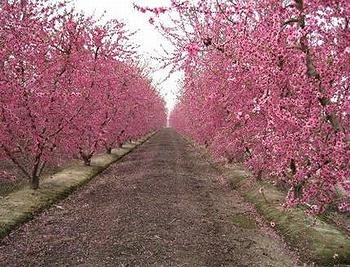根據加州大學戴維斯分校和華盛頓大學最近的調研結果顯示,多種水果和堅果樹尾隨一段休眠期,需要經過特定時數的寒流洗禮之後,接下來在春天開花。
 但全球暖化致使加州的氣候不利於這些高經濟作物的生長。但研究人員發現,部分農業發達的加州中部河谷平原(Central Valley)地區,面臨冬季暖化的問題,低溫的時數比過去少了近30%。他們還表示,暖化的現象會日益加遽。
但全球暖化致使加州的氣候不利於這些高經濟作物的生長。但研究人員發現,部分農業發達的加州中部河谷平原(Central Valley)地區,面臨冬季暖化的問題,低溫的時數比過去少了近30%。他們還表示,暖化的現象會日益加遽。
研究人員利用氣候模擬得到的數據作爲聯合國政府間氣候變遷小組(IPCC)的最新評估並預測,以1950年爲基準,到本世紀中葉冬季寒流時數將減少60%,到2100年將低於80%。
該研究小組發現截至2000年,冬天低溫的時數已經少到一個程度,以至於加州中部河谷平原僅剩4%的地方仍適合種植蘋果、櫻桃、梨等作物。恰巧所有這些作物都需要寒流的加持。
研究人員預計到2100年,中部河谷平原可能不再適合種植核桃、開心果、桃、杏、李子、櫻桃等果樹。
該項研究為第一個對全加州的寒流時數做出詳細的預測。而寒流的洗禮對該地區近300萬英畝的水果和堅果果樹是必要的。根據加州食品和農業部(Department of Food and Agriculture),這些作物於2007年的總產值為78億美元。
為避免在冬季凍傷,大多數非熱帶水果和堅果樹在秋季落葉,爾後進入休眠狀態。而恢復生長之前,果樹必須歷經一定時數的寒流,一般的説法就是曝露於介於32和45華氏度的寒流時數。
為準確預測寒流的時數,研究人員大量使用了從1950年至2000年間的每個鐘點和每天的氣溫記錄,以及18個不同的氣候情境來預測未來本世紀的景況。
其中他們介紹了「安全寒冬時數」的概念,也就是90%的所有預測年份中,可安全預期的寒冬時數。他們計算了每個情境的安全寒冬時數,並量化特定作物因安全寒冬時數而產生的土地面積變化。
研究人員發現,所有預測的情境中,加州的寒冬時數呈現下滑的狀況。
資助這項研究的是加州食品和農業部和美國自然保育協會(Nature Conservancy)。該研究結果刊登於公共科學圖書館雜誌(PLoS ONE)。
Many fruit and nut trees need chilly winters to emerge from their dormant period and begin to flower in spring, but global warming is already making California's climate too hot for these lucrative crops, according to new research from the University of California, Davis and the University of Washington.
In some parts of California's agriculturally rich Central Valley, winter chill has already declined by nearly 30 percent, the researchers found, and they say more warming is on the way.
The researchers projected that winter chill will have declined from the 1950 baseline by as much as 60 percent by the middle of this century and by up to 80 percent by 2100, using data from climate models developed for the most recent assessment of the UN's Intergovernmental Panel on Climate Change.
The research team found that by the year 2000, winter chill had already declined to the point that only four percent of the Central Valley was still suitable for growing apples, cherries and pears, all of which need winter chill.
The researchers project that by the year 2100, the Central Valley might no longer be suitable for growing walnuts, pistachios, peaches, apricots, plums and cherries.
The study is the first to map winter chill projections for all of California, which is home to nearly three million acres of fruit and nut trees that require chilling. The combined production value of these crops was $7.8 billion in 2007, according to the California Department of Food and Agriculture.
Most nontropical fruit and nut trees avoid cold injury in the winter by losing their leaves in the fall and entering a dormant state.
To resume growth, the trees must experience a certain amount of winter chill, traditionally expressed as the number of winter chilling hours between 32 and 45 degrees Fahrenheit. To provide accurate projections of winter chill, the researchers used hourly and daily temperature records from 1950 and 2000, as well as 18 climate scenarios projected for later in the 21st century.
They introduced the concept of "safe winter chill," the amount of chilling that can be safely expected in 90 percent of all years. They calculated the amount of safe winter chill for each scenario and also quantified the change in area of a safe winter chill for certain crop species.
The researchers found that in all projected scenarios, the winter chill in California declined over time.
Funding for this study was provided by the California Department of Food and Agriculture and The Nature Conservancy. The findings appear in the online journal PLoS ONE.





